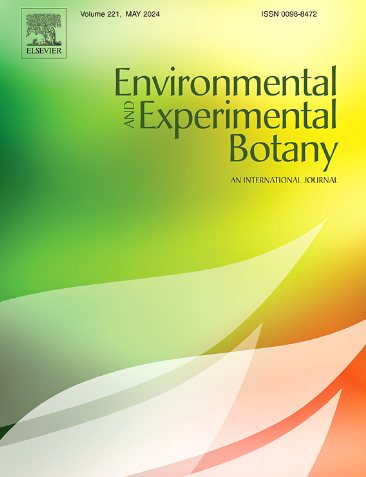不同干旱条件下叶面积对羊草叶绿素荧光的调节作用
IF 4.7
2区 生物学
Q2 ENVIRONMENTAL SCIENCES
引用次数: 0
摘要
植物对干旱的光合反应已被广泛探索,主要是通过室内栽培或短期生理监测。然而,在各种干旱条件下,特别是在全球降水变化的背景下,将牧草光合作用与植物性状和产量联系起来的研究还很有限。通过4年的野外试验,研究了环境降水、强干旱(ID, 6月降水排除)、慢性干旱(CD, 6 - 8月降水减少一半)和6 - 8月降水频率减少一半(RF,降水再分配不改变降水量)的不同降水处理。结果表明,ID和CD显著降低了羊草PSII的实际最大光化学量子产率(ΦPSII)和最大光化学量子产率(Fv/Fm),表明羊草光合能力下降。同时,调节能量耗散量子产率(Φ(NPQ))的增加突出了光保护的增强。此外,CD增加了非调节能量耗散量子产率(Φ(NO)),表明光保护机制不足以耗散多余的激发能,导致反应中心发生光损伤。相反,在RF情景下,植物通过增加Φ(NPQ)有效地管理多余的激励能量,从而防止了损伤并保持了稳定的ΦPSII和Fv/Fm水平。干旱通过调节叶面积增加Φ(NO),降低Fv/Fm。该策略虽然减轻了进一步的光合损害,但也降低了羊草的光合效率和生产力。本研究首次探索了植物光合过程在不同干旱情景下的模式和机制。该研究强调了植物叶面积等关键性状在变化降水模式下调节光合响应中的重要作用,为草地管理和牧草持续供应提供了有价值的信息。本文章由计算机程序翻译,如有差异,请以英文原文为准。
Leaf area modulates the chlorophyll fluorescence of Leymus chinensis in response to different drought scenarios
The photosynthetic response of plants to drought has been widely explored, primarily through indoor cultivation or short-term physiological monitoring. However, studies linking the photosynthesis of forage with plant traits and production under various drought conditions, especially in the context of global precipitation changes, are limited. We conducted a four-year field experiment involving different precipitation treatments: ambient precipitation, intense drought (ID, precipitation exclusion during June), chronic drought (CD, reducing half precipitation amount from June to August), and reducing half precipitation frequency from June to August (RF, precipitation redistribution without changing precipitation amount). Our results showed that ID and CD significantly decreased the actual maximum photochemical quantum yield of PSII (ΦPSII) and maximum photochemical quantum yield (Fv/Fm), indicating a decline in photosynthetic capacity in Leymus chinensis. Meanwhile, the increase in regulatory energy dissipation quantum yield (Φ(NPQ)) highlighted enhanced photoprotection. Additionally, the CD increased the non-regulatory energy dissipation quantum yield (Φ(NO)), indicating that the photoprotection mechanism was insufficient to dissipate excess excitation energy, leading to photodamage at the reaction center. In contrast, under the RF scenario, plants effectively managed excess excitation energy by increasing Φ(NPQ), which prevented damage and maintained stable ΦPSII and Fv/Fm levels. Through regulating leaf area, drought increased Φ(NO) and decreased Fv/Fm. Although this strategy mitigated further photosynthetic damage, it also reduced photosynthetic efficiency and productivity of L. chinensis. This study represents the first exploration of patterns and mechanisms of plant photosynthetic processes in response to diverse drought scenarios. It underscores the crucial role of key plant traits, i.e. leaf area, in regulating photosynthetic responses amid changing precipitation patterns, and provides valuable information for grassland management and continuous forage supply.
求助全文
通过发布文献求助,成功后即可免费获取论文全文。
去求助
来源期刊

Environmental and Experimental Botany
环境科学-环境科学
CiteScore
9.30
自引率
5.30%
发文量
342
审稿时长
26 days
期刊介绍:
Environmental and Experimental Botany (EEB) publishes research papers on the physical, chemical, biological, molecular mechanisms and processes involved in the responses of plants to their environment.
In addition to research papers, the journal includes review articles. Submission is in agreement with the Editors-in-Chief.
The Journal also publishes special issues which are built by invited guest editors and are related to the main themes of EEB.
The areas covered by the Journal include:
(1) Responses of plants to heavy metals and pollutants
(2) Plant/water interactions (salinity, drought, flooding)
(3) Responses of plants to radiations ranging from UV-B to infrared
(4) Plant/atmosphere relations (ozone, CO2 , temperature)
(5) Global change impacts on plant ecophysiology
(6) Biotic interactions involving environmental factors.
 求助内容:
求助内容: 应助结果提醒方式:
应助结果提醒方式:


